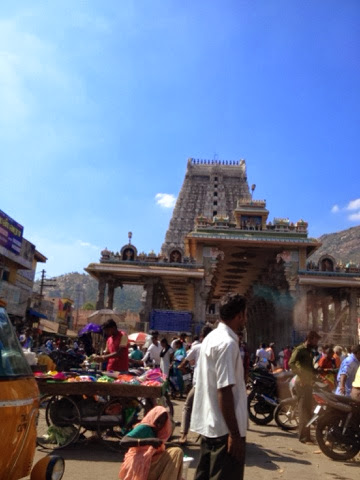It is impossible to visit India without seeing temples. They are like churches in the U.S. in that they are ubiquitous. They are different in that they are usually much more ornate. Some temples are truly amazing and attract a lot of tourists, both foreign and domestic. Temples are also often destinations for pilgrims. It is estimated that there are several hundred thousand Hindu temples in India. The official government count for Tamil Nadu, the state I am visiting, is 34,000. Ravi said it's probably double that if you count all the little village temples.
Last month when Barbara and I were on our road trip, we visited a number of temples. The first was the Arunachalaeshwar temple in Tiruvannamalai, not far from the Ramana Ashram. (Remember - the place where we ate sitting on the floor from banana leaves.). We visited the temple on Pongal, the festival day. Both the temple and the crowd were overwhelming.
Arunachaleshwar temple seen from a distance. This is not a picture I took, of course, but only with this perspective can you get an idea of the immensity of it.
The temple is situated at the foot of Arunachala hill, which is believed by many to have special religious significance. This hill is what brought Sri Ramana to Tiruvannamalai, and in fact Sri Ramana lived in the temple for about 6 months when he first arrived here. The temple covers 24 acres, and is the largest Shaiva temple in India. It is believed to have been around for about 2000 years, although the towers and columns probably date back about 1200 years.
A word about The Hindu religion. There are a lot of gods and goddesses, and most can be categorized as either Shaiva or Vaishna gods, so the temples usually fall into one or the other of these categories. I may try to tackle a blog entry on this topic in the future, but I haven't even really gotten a good start on Hinduism for beginners. I've been quizzing Ravi on this, and was thinking about finding a book that would lay it all out neatly for me. But Ravi said most Indians don't really care about that. They choose their god or goddess for their own reasons, either because it was their family or community deity, or due to a personal reason. So I may or may not try to figure it out, and for now, I'll just leave it at that.
In retrospect, it would have benefited us to do a little more homework before we went to the temple. As it was, we weren't even sure exactly which gate we got dropped off at. The crowds were so thick, we were lucky to get to any gate! We joined the throngs of people, left our shoes with all the others, and headed into the gate. As you can see, there are temples within temples here, and we just kind of followed the crowds. Actually, the pavement was so hot that at one point our main objective was to find a shady spot to head towards so our feet wouldn't burn up. This was good preparation for walking on hot coals, in case we ever decide to give that a try.
Once we got into the depths of the inner temple it was dark and felt very closed in. There were long queues to get into the innermost sanctum, which we opted to forego. We didn't want to find ourselves somewhere we weren't supposed to be. We didn't see any other non-Indians, and in fact we became the tourist attraction when we were asked to pose with children so they could have their pictures taken with us! Everyone was very friendly, but it was kind of overwhelming. We discovered that many of the people there were from other parts of India, and were there to celebrate Pongal.
A disclaimer. It is very difficult to take picture of anything so big. I also felt a little conspicuous taking pictures, so I took fewer pictures than I might have otherwise. I chose not to take any pictures at all inside the inner temple.
Outside the temple there are lots of street vendors.
Looking back at one of the towers once we had entered the temple gate.
A kolam that was beginning to show wear after all the people walking on it.










Love your blog posts, Harlene. Nice mix of educational facts, and personal touches such as the burning feet - makes it more human, allows me to really feel what it's like to be there. Keep 'em coming please!
ReplyDeleteAnd I didn't mean education in a bad way :) -- fascinating stuff. Love tidbits like the hundreds of thousands of temples, and apparently thousands of people or gods carved on the temple.
ReplyDeleteThank you for your kind words! I love knowing that people are actually reading this. I also learn a lot doing them, since I do research every time I do a blog. And I also get to relive the experience, as I look back through my pictures.
DeleteMore powerful pictures and commentary!!!...FASCINATING STUFF!!!
ReplyDeleteHarlene,
ReplyDeleteYour blog is fabulous! Your pictures make your trip so vivid--and stir up all my old memories of being in Thailand and experiencing all of the exotic sights--just as you are in India. Thank you!